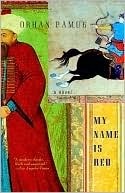More on this book
Community
Kindle Notes & Highlights
When you love a city and have explored it frequently on foot, your body, not to mention your soul, gets to know the streets so well after a number of years that in a fit of melancholy, perhaps stirred by a light snow falling ever so sorrowfully, you’ll discover your legs carrying you of their own accord toward one of your favorite promontories.
Where there is true art and genuine virtuosity the artist can paint an incomparable masterpiece without leaving even a trace of his identity.
The images are the story’s blossoming in color. But painting without its accompanying story is an impossibility.
This was the essence of ‘portraiture.’ “If your face were depicted in this fashion only once, no one would ever be able to forget you, and if you were far away, someone who laid eyes on your portrait would feel your presence as if you were actually nearby. Those who had never seen you alive, even years after your death, could come face-to-face with you as if you were standing before them.”
For if a lover’s face survives emblazoned on your heart, the world is still your home.
A letter doesn’t communicate by words alone. A letter, just like a book, can be read by smelling it, touching it and fondling it. Thereby, intelligent folk will say, “Go on then, read what the letter tells you!” whereas the dull-witted will say, “Go on then, read what he’s written!”
Perhaps one day someone from a distant land will listen to this story of mine. Isn’t this what lies behind the desire to be inscribed in the pages of a book?
I thank Allah that I, the humble tree before you, have not been drawn with such intent. And not because I fear that if I’d been thus depicted all the dogs in Istanbul would assume I was a real tree and piss on me: I don’t want to be a tree, I want to be its meaning.
Painting is the silence of thought and the music of sight.
imperfection gives rise to what we call ‘style,’”
“If love is part of the subject of the painting, the work ought to be rendered with love,” I said. “If there’s pain involved, pain should issue from the painting. Yet the pain ought to emerge from the at first glance invisible yet discernible inner harmony of the picture, not from the figures in the illustration or from their tears. I didn’t depict surprise, as it has been shown for centuries by hundreds of master miniaturists, as a figure with his index finger inserted into the circle of his mouth, but made the whole painting embody surprise.
Thus was I better able to understand Ibn Arabi’s notion that love is the ability to make the invisible visible and the desire always to feel the invisible in one’s midst.
“It’s not experience of subject matter that makes us masters, it’s never having experienced it that makes us masters.”
The greatest of sins is committed by painters who presume to do what He does, who claim to be as creative as He.”
“Nothing is pure,” said Enishte Effendi. “In the realm of book arts, whenever a masterpiece is made, whenever a splendid picture makes my eyes water out of joy and causes a chill to run down my spine, I can be certain of the following: Two styles heretofore never brought together have come together to create something new and wondrous.
A great painter does not content himself by affecting us with his masterpieces; ultimately, he succeeds in changing the landscape of our minds.
“A miniaturist,” said Enishte Effendi in the tone of a self-satisfied man, “creates his art by heeding his conscience and by obeying the principles in which he believes, fearing nothing. He pays no attention to what his enemies, the zealots and those who envy him have to say.”
Color is the touch of the eye, music to the deaf, a word out of the darkness.
“The truth is contentment. Love and marriage are but a means to obtaining it: a husband, a house, children, a book.
Let’s say we were to turn down a street: In a Frankish painting, this would result in our stepping outside both the frame and the painting; in a painting made following the example of the great masters of Herat, it’d bring us to the place from which Allah looks upon us; in a Chinese painting, we’d be trapped, because Chinese illustrations are infinite.
The beauty and mystery of this world only emerges through affection, attention, interest and compassion; if you want to live in that paradise where happy mares and stallions live, open your eyes wide and actually see this world by attending to its colors, details and irony.
regardless of whether the illustration was made today or a hundred years ago, whether it’s a depiction of war or love, what the artist of absolute faith actually paints and conveys is a battle with his will and his love for painting;
“To paint is to remember.”
To see that the pictures in the second of the legendary books, made when he was blind, were simpler and purer, while the colors in the first volume were more lively and invigorating, reminded me that the memory of the blind exposes the merciless simplicity of life but also deadens its vigor.


